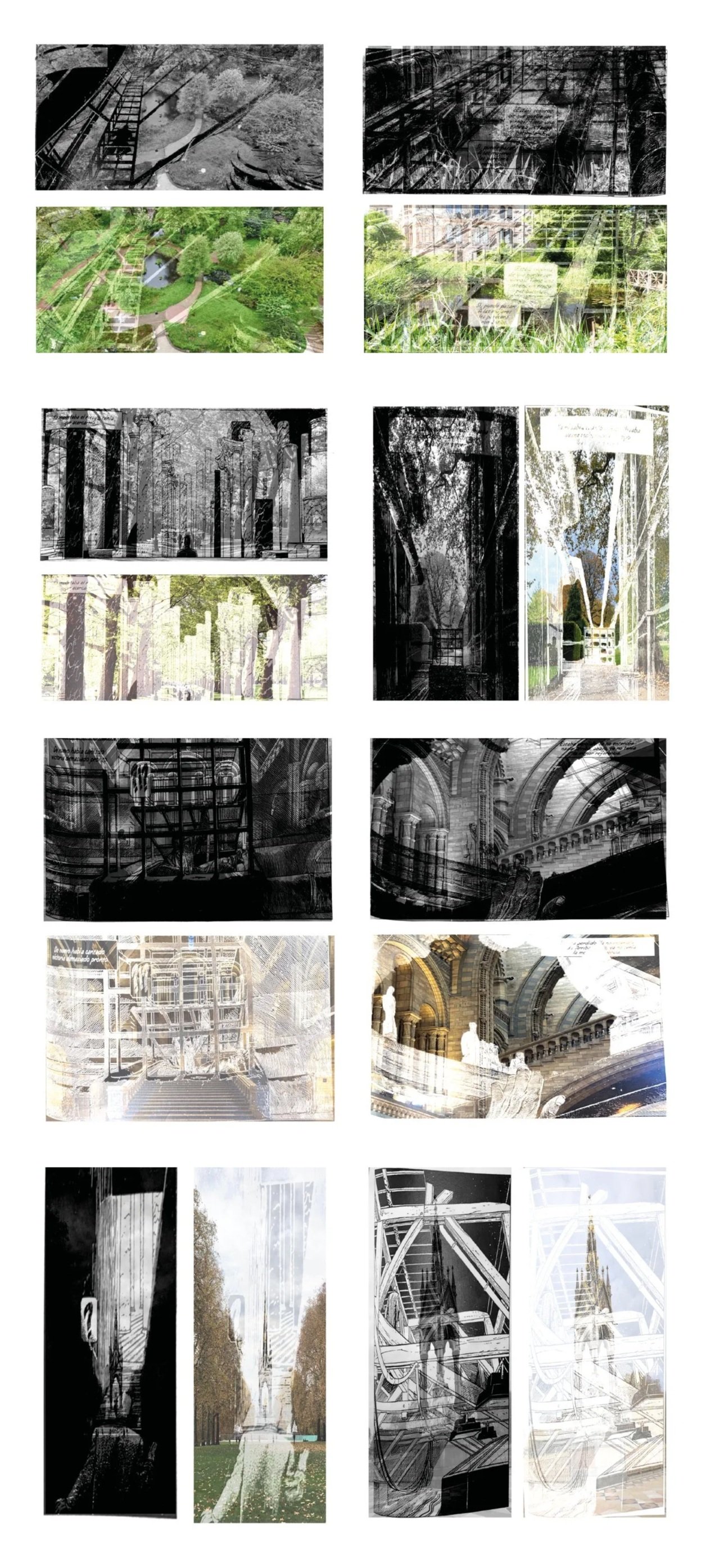The Salon Of Crossed Destinies: Porosity And Natural History
ClientInstitution
University of Westminster, London, UK
Year
2020
Anchored in the myth of the Tower of Babel, the project explores fragmentation, multiplicity, and the flow of knowledge across time. Drawing from Walter Benjamin’s notion of porosity and Italo Calvino’s The Castle of Crossed Destinies, it constructs a spatial narrative where meaning seeps between architecture, landscape, and memory.
A forest of golden columns marks the traces of unrealized architectures in Hyde Park, creating a dialogue between factual and fictional natures, between what is preserved and what is imagined. Through drawings, tarot cards, and collages, the project reads Natural History not as a fixed collection, but as a living, porous continuum where stories, materials, and ecologies remain in constant transformation.
The Salon of Crossed Destinies reimagines the museum as a porous landscape, an open archive of intertwined natural and cultural histories. Situated across Albertopolis and Hyde Park, the project unfolds through four interlinked galleries that invite visitors to read, debate, and perform history as an embodied and collective experience.
The Tower of Babel by Pieter Bruegel the Elder
The museum as a porous landscape — an open, living archive of knowledge, memory, and ecological time.
Originally conceived as a constellation of spatial interventions across Albertopolis and Hyde Park, the project sought to reveal the tensions between preservation and transformation, artifice and nature, history and myth.
The Salon unfolds through four interconnected galleries situated opposite the Albert Memorial, conceived as a contemporary reinterpretation of the Victorian salon, a space of exchange, experience, and collective learning. Each gallery hosts a distinct form of engagement: reading, debating, acting, and observing. Together, they construct a performative ecology of knowledge in which the act of learning becomes spatial, embodied, and interdependent.
At the heart of the proposal lies the notion of porosity, understood not only as a physical condition of space but as an epistemological lens through which to read the flows of history, nature, and human intention. Drawing from Walter Benjamin’s reflections on Naples and Italo Calvino’s The Castle of Crossed Destinies, the project reinterprets architecture as a network of porous narratives, where meaning seeps through time and material, continuously reshaped by encounter and reinterpretation.
The project’s symbolic axis emerges from the myth of the Tower of Babel, reimagined as a metaphor for multiplicity and the fragmentation of knowledge. Rather than lamenting its collapse, The Salon celebrates Babel’s generative potential, the birth of many languages, many readings, many worlds. The tower becomes an allegory for the Natural History Museum itself: a monument of classification and ambition, yet also a living organism of shifting interpretations and forgotten connections.
Within this framework, a forest of golden columns rises in Hyde Park, marking the ghost foundations of the unbuilt National Gallery, a gesture towards what remains unseen and imagined. This speculative structure dialogues with the Wildlife Garden and the Hintze Hall, negotiating between factual and fictional natures: the garden as “nature caring for nature,” the hall as “human caring for human.” Through these dualities, The Salon constructs an ecology of correspondences between human and non-human agencies, between architecture and the landscape it inhabits.
Tarot cards, drawings, and collages act as mediating tools, a speculative archive that merges historical documentation with fictional reconstruction. Each card translates a spatial or temporal condition: “space without boundaries,” “constant change,” “reference point,” “building within buildings.” Together, they form a reading of Natural History as porous and cyclical, a continuum of matter, memory, and imagination.
Through this interplay of myth, site, and speculation, The Salon of Crossed Destinies becomes less an architectural project than an environmental narrative: a device for re-seeing and re-sensing our entanglement with the material histories that surround us. In revisiting Victorian ideals of order and display, it proposes instead a “sweet disorder” an architecture of care, openness, and ecological empathy.





